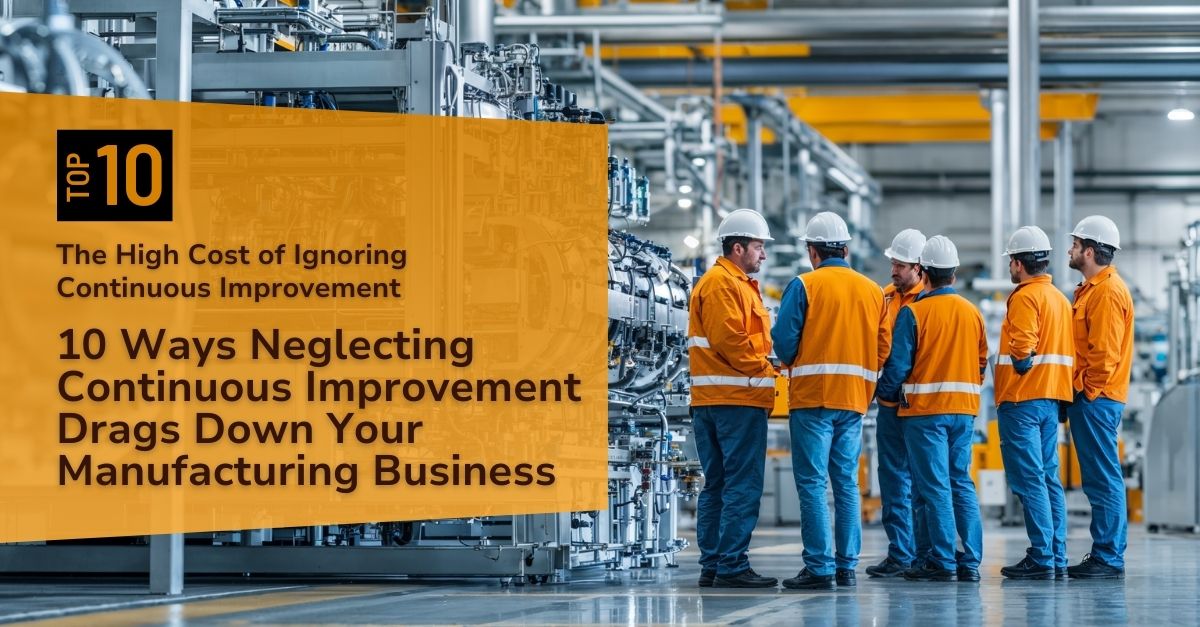
Change is constant in manufacturing, whether it’s evolving customer expectations, stricter regulations, or new technologies entering the market.
Yet in many plants, change is met with hesitation. Leaders may see the need to adapt, but on the floor, entrenched routines, siloed communication, and inconsistent training often slow down progress.
Without a strong foundation in Shop Floor Excellence (SFE), that resistance to change becomes a real barrier. It delays innovation, increases waste, and weakens a company’s ability to respond to external pressures.
In this sixth installment of our series, we break down 10 common ways resistance to change shows up in manufacturing, and how integrating SFE principles can help leaders and teams overcome these challenges with structure, speed, and confidence.
1Reluctance to Adopt New Technologies:
Whether it’s automation, new software, or upgraded machinery, many organizations face pushback when introducing unfamiliar tools. Concerns about downtime, complexity, or job security can quickly derail adoption, even when the long-term benefits are clear.
Solution: Start small. Pilot new tech in a single cell or process, track specific metrics (like setup time or defect rates), and share those wins broadly. Provide job-specific training that ties directly to how employees work. When people see how a tool improves their output, not just the company’s bottom line, they’re more likely to engage.
2Inflexible Production Processes:
Legacy equipment, outdated layouts, and rigid workflows make it hard to switch gears quickly. When a customer requests a customization or a new product line, even small changes can trigger major disruptions.
Solution: Invest in flexible manufacturing systems and cross-train your workforce to support agility. Use lean tools like SMED to reduce changeover times and create modular workstations that can be reconfigured without starting from scratch. An adaptable process isn’t just a competitive advantage, it’s a requirement for staying relevant.
3Slow Response to Market Trends:
Markets shift faster than traditional planning cycles can handle. If your teams rely on static forecasts or siloed information, you’ll miss windows of opportunity, or worse, keep producing goods no one wants.
Solution: Build market intelligence into your strategic cadence. Establish a cross-functional team tasked with trend tracking and scenario planning. Integrate SFE’s structured daily and weekly team reviews to quickly align production with what the market is asking for. Reactivity becomes readiness when insights move freely through your organization.
4Limited Product Development:
A stagnant product line often signals a deeper issue: internal resistance to experimentation. Without a clear process to test and refine new ideas, product development stalls, and customers look elsewhere.
Solution: Create a formal feedback loop between the floor and product teams. Frontline operators often spot opportunities for design tweaks that improve usability or reduce cost. Host monthly innovation reviews and carve out R&D time that’s protected from firefighting. SFE gives this effort structure, ensuring development aligns with capability and capacity.
5Inefficient Problem-Solving:
Recurring issues, like rework, short stops, or changeover delays, are often “patched” rather than solved. People learn to work around the problems, but over time, the impact adds up: lower yield, higher scrap, and frustrated teams.
Solution: Use structured methodologies like A3, DMAIC, or 5 Whys to drive real root cause analysis. Implement daily tier meetings to flag problems early, assign owners, and track resolution visibly. SFE creates a rhythm for resolving, not just reporting, issues, turning problem-solving into a daily habit, not an annual initiative.
6Low Employee Engagement in Innovation:
If your workforce feels disconnected from improvement efforts, ideas stop flowing. People stop raising their hands, not because they don’t have ideas, but because they don’t think it matters.
Solution: Build idea generation into your operating system. Use whiteboards, digital apps, or team huddles to gather input, and follow up publicly on every submission. Even if an idea isn’t used, show that it was heard. Recognize contributions with more than a pat on the back, tie it to advancement, bonuses, or development paths. SFE thrives when every team member feels invested.
7Poor Adaptation to Regulatory Changes:
Regulatory changes, whether from OSHA, FDA, EPA, or industry-specific bodies, can disrupt operations overnight. If your team isn’t trained to spot changes or respond quickly, you risk fines, shutdowns, and reputational damage.
Solution: Build compliance into your SFE system. Assign ownership for monitoring changes, update SOPs through controlled documentation, and use layered audits to verify adoption on the floor. Don’t rely solely on annual training, build compliance awareness into daily stand-ups and Gemba walks to keep teams aligned and inspection-ready.
8Inadequate Training and Skill Development:
When systems change but training doesn’t, people struggle. Outdated training programs often don’t reflect new technology, new standards, or new responsibilities, leaving operators unsure and unprepared.
Solution: Create a dynamic training plan that evolves with the process. Use job instruction sheets, on-the-job coaching, and microlearning modules to reinforce learning continuously. Build skills matrices to identify gaps and plan cross-training. Training shouldn’t be a box to check, it should be a competitive advantage.
9Failure to Leverage Data Analytics:
Most manufacturers collect massive amounts of data, from OEE and downtime to yield and first-pass quality. But without context and action, that data sits unused, creating “reporting fatigue” and frustration.
Solution: Simplify your KPIs and tie them to frontline decisions. Build dashboards into daily team routines, using visual controls to highlight trends and trigger problem-solving. Make data accessible to the people who can act on it, and equip them with the tools to do so. When data becomes part of the conversation, improvement accelerates.
10Conservative Organizational Culture:
Risk-averse teams often hesitate to try new things, fearing failure, criticism, or simply stepping outside what’s familiar. While caution is valuable, too much of it slows down progress and keeps good ideas on the shelf.
Solution: Use SFE to provide a framework for testing and learning. Pilot improvements with clear criteria, track performance, and celebrate both wins and lessons. Leaders must model the behavior they want to see: openness, experimentation, and resilience. Innovation isn’t chaotic when it’s managed through structure, and that structure builds confidence.
How POWERS Helps Manufacturers Break Through Resistance to Change
At POWERS, we’ve seen how resistance to change plays out firsthand, from small bottlenecks to large-scale performance gaps. Our job is to help manufacturers build the systems, capabilities, and leadership behaviors that make change easier to manage, and more likely to succeed.
We apply Shop Floor Excellence as a foundational discipline, giving leaders and teams the daily structure to drive innovation and improvement.
Through practical tools like tiered team huddles, root cause routines, flexible planning frameworks, and frontline coaching, we help companies stop fearing change and start leveraging it.
And when digital transformation is part of the solution, our Digital Production System (DPS) brings critical visibility, accountability, and speed to every layer of the operation. DPS works hand-in-hand with SFE, enabling real-time adjustments and empowering teams with better insights.
Contact us at +1 678-971-4711 or info@thepowerscompany.com for a comprehensive solution that aligns your manufacturing processes with the forefront of innovation and change management. Let’s work together to drive your manufacturing productivity to new heights.
Continue Reading from this Mastery Series
- Part 1 - The Perils of Overlooking SFE in Assembly Line Setup
- Part 2 - A Lackluster Approach to Shop Floor Excellence Impacts Workforce Engagement
- Part 3 - The Consequences of Sidestepping Data-Driven Decisions in Shop Floor Excellence
- Part 4 - Without Shop Floor Excellence, Product Quality Can Drop Like a Rock
- Part 5 - A Lack of Commitment to Shop Floor Excellence Can Lead to These 10 Safety Issues
- Part 6 - Shop Floor Excellence Makes Your Operation More Agile, Flexible, and Adaptable to Market Changes
- Part 7 - Bridging the Gap with Effective Communication in Shop Floor Excellence
- Part 8 - How Ignoring Shop Floor Excellence Undermines Continuous Improvement
- Part 9 - Tackling Inefficient Energy and Material Use with Shop Floor Excellence
- Part 10 - Enhancing Customer Focus Through Shop Floor Excellence







